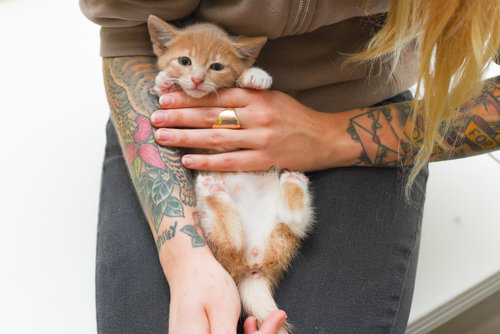Helping Kittens with Tapeworms
Seeing grains of rice in your kitten’s poop or around their butt? Find something small and white sticking to their fur or wiggling around the litter box? If you’re spotting short, flat, white segments around your kitten’s stool, there’s a pretty good chance the kitten has tapeworms. But don’t worry—follow the advice below and soon they’ll be tapeworm free!
What Are Tapeworms?
Tapeworms are intestinal parasites that attach to the kitten’s gut using hook-like structures in their mouths. These worms absorb nutrients from the kitten, growing longer and periodically shedding segments containing eggs, which are expelled through the feces. These long, flat parasites have segmented bodies, and may be seen either as one very long worm or as individual segments that may be seen near the butt or in the litter box. Living segments are flat and rectangular and move slowly, dried out segments may be more yellow or cream-colored and look like sesame seeds.
Left untreated, tapeworms can become a big problem for little kittens, causing issues like nutritional deficiency, gastrointestinal distress, weight loss, and general decline.
How to Know if Your Kitten Has Tapeworms
Tapeworms can be noted visually when the presence of small, white, rice-like segments is seen near the kitten's butt or in their stool.
But in some cases, tapeworms can be present without any visual cues. If you’re observing signs such as excessive licking or scooting, GI distress, weight loss, or general unthrifiness, or if you know that the kitten has had fleas, it’s a good idea to talk to your veterinarian about fecal examination. You may be asked to bring in a stool sample from the kitten, which may be examined at the clinic or may be sent out to a laboratory for antigen testing. Kittens can be infected with many different types of parasites, and it’s important to get a proper diagnosis from a veterinarian to ensure that you’re following the right steps.
How Kittens Get Tapeworms
The primary way that kittens get tapeworms is through the ingestion of an infected flea carrying tapeworm eggs. Kittens may consume a flea when grooming, or when biting at a spot on their fur that is itchy. Once consumed, the digested fleas may release tapeworm larvae into the digestive tract. For this reason, any kitten who has had fleas should also be monitored for signs of tapeworms.
It’s also possible to become infested with tapeworms by consuming raw meat that is infected with tapeworm larvae, or by coming into contact with objects in the environment that are contaminated, such as bedding and litter boxes. For this reason, disinfection is of great importance when dealing with tapeworms!
Treating Tapeworms
Tapeworms are treated using an antiparasitic medication such as praziquantel. While this may be accessible over the counter, it’s still a good idea to talk to your veterinarian for a diagnosis and dosing information. Medication should always be dosed to the weight of the individual kitten.
It’s important to know that there is no dewormer that treats every parasite. Even if your kitten has “been dewormed,” it’s possible they were not treated for tapeworms. Many parasites have similar symptoms, but totally different treatment needs, so talk with your veterinarian and ensure that the kitten has a correct diagnosis and treatment plan. A veterinarian can help you determine which parasite is present, and what treatment is needed.
Avoid Reinfestation!
When treating a kitten for tapeworms, it’s important to simultaneously treat them and their environment for fleas. Read my article on flea treatment for kittens, as many commercial flea medications are not safe for kittens. Ensure that you’re sanitizing the kittens’ environment, including the litter box, and washing all bedding to eliminate any residual eggs and prevent reinfestation.
Early Intervention is Key
When it comes to kitten health, time is of the essence. Anytime you witness GI distress such as diarrhea, constipation, or other poop problems, you’ll want to take action immediately to have the best outcome.




